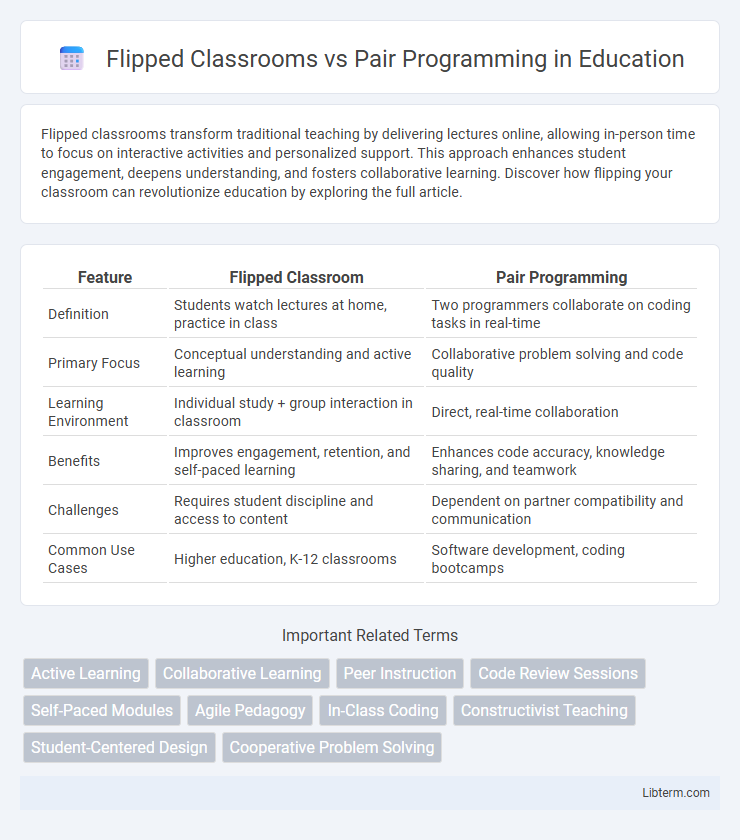Flipped classrooms transform traditional teaching by delivering lectures online, allowing in-person time to focus on interactive activities and personalized support. This approach enhances student engagement, deepens understanding, and fosters collaborative learning. Discover how flipping your classroom can revolutionize education by exploring the full article.
Table of Comparison
| Feature | Flipped Classroom | Pair Programming |
|---|---|---|
| Definition | Students watch lectures at home, practice in class | Two programmers collaborate on coding tasks in real-time |
| Primary Focus | Conceptual understanding and active learning | Collaborative problem solving and code quality |
| Learning Environment | Individual study + group interaction in classroom | Direct, real-time collaboration |
| Benefits | Improves engagement, retention, and self-paced learning | Enhances code accuracy, knowledge sharing, and teamwork |
| Challenges | Requires student discipline and access to content | Dependent on partner compatibility and communication |
| Common Use Cases | Higher education, K-12 classrooms | Software development, coding bootcamps |
Introduction to Flipped Classrooms and Pair Programming
Flipped classrooms invert traditional teaching by delivering instructional content outside of class through videos or readings, enabling in-class time for interactive activities and personalized support. Pair programming involves two developers collaborating at one workstation, where one writes code (the driver) and the other reviews each line (the navigator), enhancing code quality and knowledge sharing. Both methods emphasize active learning and collaboration but differ in their primary focus: flipped classrooms center on restructuring content delivery, while pair programming targets real-time coding cooperation.
Core Principles of Flipped Classrooms
Flipped classrooms center on reversing traditional teaching by delivering instructional content outside of class, often through video lectures, allowing in-class time for interactive activities and problem-solving that reinforce understanding. This approach promotes active learning, student engagement, and personalized pacing, enabling learners to prepare at their own speed and apply knowledge collaboratively during class. Core principles emphasize pre-class content delivery, in-class active learning, and continuous formative assessment to support deeper comprehension and skill mastery.
Fundamental Concepts of Pair Programming
Pair programming emphasizes two developers collaborating at one workstation, constantly switching roles between "driver" and "observer" to enhance code quality and problem-solving efficiency. This method fosters real-time feedback, shared knowledge, and collective code ownership, which contrasts with flipped classrooms where students learn independently before applying concepts interactively. The fundamental concept of continuous collaboration and communication in pair programming directly improves debugging skills and accelerates learning through peer interaction.
Key Differences Between the Two Approaches
Flipped classrooms emphasize individualized learning through pre-class content engagement, allowing students to absorb theoretical material independently before participating in interactive, teacher-led activities during class time. Pair programming centers on collaborative coding, where two developers work together synchronously on the same task, enhancing code quality and knowledge sharing in real-time. The key difference lies in the flipped classroom's focus on shifting direct instruction outside class for broader group activities versus pair programming's continuous, shared hands-on practice emphasizing immediate problem-solving and peer feedback.
Learning Outcomes: Flipped Classrooms vs Pair Programming
Flipped classrooms enhance learning outcomes by allowing students to engage with instructional content at their own pace, promoting deeper understanding through pre-class preparation and active in-class problem solving. Pair programming improves coding skills and collaborative learning, leading to higher retention of programming concepts and faster debugging through real-time peer feedback. Both methods boost critical thinking and problem-solving abilities, but flipped classrooms emphasize individual comprehension while pair programming fosters teamwork and immediate knowledge exchange.
Engagement and Collaboration in Both Methods
Flipped classrooms enhance student engagement by shifting content delivery outside of class, allowing in-person time to focus on collaborative problem-solving and active discussions. Pair programming fosters real-time collaboration and immediate feedback as two developers work together on code, increasing focus and shared learning. Both methods promote deeper understanding through interactive participation, with flipped classrooms emphasizing self-paced preparation and pair programming maximizing cooperative execution.
Challenges and Limitations of Each Approach
Flipped classrooms often face challenges such as student resistance to pre-class preparation and the digital divide impacting access to online materials, limiting equitable participation. Pair programming encounters limitations like potential personality clashes, unequal workload distribution, and the necessity for compatible skill levels to ensure effective collaboration. Both approaches require careful implementation and support structures to address these inherent obstacles and maximize learning outcomes.
Technology Requirements and Classroom Setup
Flipped classrooms demand reliable internet access, multimedia devices such as tablets or laptops, and a learning management system to distribute pre-class materials efficiently. Pair programming requires dual workstations equipped with collaborative software, real-time code sharing tools, and ergonomic setups to enhance communication and productivity. Both methods benefit from interactive whiteboards and high-speed Wi-Fi to facilitate seamless technology integration and an adaptive learning environment.
Best Use Cases for Flipped Classrooms and Pair Programming
Flipped classrooms excel in environments where learners benefit from self-paced, pre-class content review, such as higher education courses in math and science, enabling deeper in-class problem solving and interactive discussions. Pair programming thrives in software development settings that require real-time collaboration, immediate feedback, and collective code ownership, making it ideal for agile teams working on complex coding tasks. Combining flipped classrooms with pair programming can enhance coding bootcamps and technical training programs by preparing students asynchronously and maximizing live, collaborative coding practice.
Conclusion: Choosing the Right Method for Your Learners
Flipped classrooms foster independent learning by allowing students to engage with material at their own pace before collaborative activities, ideal for diverse learner profiles seeking flexibility. Pair programming enhances real-time problem-solving skills and communication, particularly effective in coding and technical subjects requiring immediate feedback. Selecting between flipped classrooms and pair programming hinges on your learners' goals, learning styles, and the subject matter complexity to maximize educational outcomes.
Flipped Classrooms Infographic

 libterm.com
libterm.com